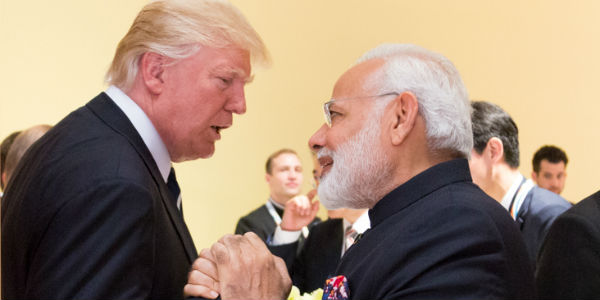Taking off the blinkers: authoritarian practices in democratic societies
In an era when there is such concern about threats to democracy from ‘authoritarian’ leaders, it is imperative that political science develops a full understanding of authoritarian practices within democratic systems, writes Marlies Glasius. These go beyond electoral malpractice and at their core are patterns of action designed to sabotage accountability.

US President Trump and Indian Prime Minister Modi. Picture: White House/Public Domain
No reader of political commentary in recent years could fail to notice a concern, perhaps even a panic, about a global tide of authoritarianism that may now be affecting even established democracies. Leaders such as Filipino President Duterte, Hungarian Prime Minister Orbán, Indian Prime Minister Modi and above all US President Donald Trump are regularly branded ‘authoritarian’, and the established democracies they head are feared to be in the process of ‘democratic backsliding’. These commentators are on to something. Their concerns are widely shared and legitimate.
But professional political scientists can give little guidance as to whether there can be such a thing as authoritarianism or autocratic leadership in a democratic society, and if so what it would look like. In the academic literature, ‘authoritarian’ means two quite different things. In comparative politics, it refers to a regime that does not organise periodic free and fair elections. Authoritarian personality theory tells us about likely correlations between holding what it calls authoritarian values and voting behaviour. But neither regime classification nor authoritarian personality theory helps us to comment intelligently on the concern that Duterte, Modi, Orbán or Trump may be ‘authoritarian’ leaders. Political science has much to say on why leaders like Duterte, Modi, Orbán or Trump get elected, but very little on how to evaluate what they do once in office. Nor can political science theories adequately respond to public accusations that the digital spying practices of Cambridge Analytica were ‘authoritarian’.
Yet without such analysis, without really understanding what authoritarianism might look like in a democratic context, we are in the dark as to what the exact problem is, and how this ‘authoritarianism’ might relate to other recent tendencies such as populism, xenophobia and nativism. Why have political scientists developed such blinkers, and how can we set about taking them off?
The failure of political science to offer clear answers to such questions is due to three main problems. First, authoritarianism is in fact a negative category: a shortfall of democracy without a definition of its own. The second problem is an excessive focus on elections, whilst the apparently natural relationship between voting in elections and actual influence on policy-making is widely doubted by citizens and political scientists alike. Third is an assumption, ignoring the impact of processes of globalisation, that authoritarianism is located only at the level of the – autonomous – nation-state. Instead, we need a definition that is substantive and dynamic rather than negative and systemic; that focuses on sabotage of accountability rather than the quality of elections alone; and that lends itself to assessing political institutions within, below or beyond the state. Consequently, a practice-oriented definition, rather than a system-oriented definition, is better suited to understanding authoritarianism today, and to answering urgent questions from society about it.
Practices are, simply put, ‘patterned actions that are embedded in particular organised contexts’. They are much more than the action or behaviour of an individual, but much less than a state structure. A focus on practices allows a shift away from designating only ‘regimes’ as authoritarian, recognising that in contemporary politics, governance arrangements can be more fluid. In this way, we can begin to imagine (and hence identify defining features of) authoritarian practices occurring in India, the United States or the EU. At the same time, practices do not narrow the focus to the individual: when considering the possibility of ‘authoritarianness’ in Hungary or the United States, we must not get obsessed with the personalities of Orbán or Trump alone, but equally consider the indispensable ‘doings and sayings’ of clusters of politicians, civil servants and public figures, at different levels, who are associated with them.
What, then, are authoritarian practices? There is a risk of unhelpfully stretching the term to encompass everything that has a negative impact on people’s lives, including discrimination, violence, corruption or inequality. At its core, authoritarianism is about the sabotage of accountability. I define an authoritarian practice as: ‘a pattern of actions, embedded in an organised context, sabotaging accountability to people over whom a political actor exerts control, or their representatives, by disabling their access to information and/or disabling their voice’. Such practices, ranging from rigging elections and locking up dissidents to censorship and disinformation via state-controlled media, are of course rife in authoritarian regimes. But they are not synonymous with authoritarian regimes. I will give two illustrations of authoritarian practices in the context of liberal democratic states.
The first example relates to deliberate spreading of disinformation by a power-holder. Politicians spin, twist and deflect from the truth all the time; but a pattern of disinformation is more than an occasional gloss on the facts. A one-off political lie does not constitute an authoritarian practice, but a pattern of inaccurate information by a number of people in authority on the same issue at different times would qualify. For instance, President Trump’s assertion that there was a record attendance at his inauguration should not be considered sustained or consequential enough to count as a pattern. But the allegations that millions of illegal migrants had fraudulently voted in the US presidential elections display a more sustained pattern. These allegations were first aired during the Trump election campaign, and then repeatedly voiced by the President himself, by his spokesman and by a White House senior adviser. They were then made the subject of an investigation headed by Vice President Mike Pence, which may have had the ultimate intention to discourage and obstruct voters from migrant backgrounds, but that got stranded because of lack of cooperation from most states.
The second example, Hungary’s media law of 2010, which established a government-controlled oversight body, illustrates ‘disabling voice’, disrupting communication flows from the people to a powerholder, speaking truth to power. Hungary’s Media Board does not formally engage in censorship, but has the authority to levy prohibitively high fines on radio and television outlets. Overseen by a party-controlled body with broad powers, and in combination with biased tendering procedures, it has had a chilling effect on Hungarian media. Both examples have been well documented, but political scientists have difficulty conceiving of such examples as ‘authoritarian practices’ because they struggle to go beyond a ‘traffic light’ approach to authoritarianism, where only the entire state can be qualified as either democratic or authoritarian.
Authoritarianism studies began with scholars like Karl Popper and Hannah Arendt, and later Juan Linz and Guillermo O’Donnell, analysing the horrific developments in their own societies with a view to learning how to counteract such trends. It turned into the professional study, from the vantage point of the West, of political systems other than, and considered inferior to, our own. In an endeavour to revitalise authoritarianism studies by going back to first principles, I have defined and illustrated authoritarian practices. Redefining authoritarianism from a practice perspective allows us to bring back home the knowledge we have developed about how authoritarianism works. Turning our gaze on our own societies, we can come to understand how authoritarian practices unfold and evolve within democracies, and in transnational settings; we can begin to see in what circumstances they thrive, and how they are best countered.
This article represents the views of the author and not those of Democratic Audit. It is based on a longer text recently published in International Affairs, vol.94, no.3, 515-533.
About the author
 Marlies Glasius is a Professor in International Relations at the Department of Politics, University of Amsterdam. Her research interests include activism, authoritarianism, and international criminal justice. Glasius holds a PhD cum laude from the Netherlands School of Human Rights Research. She previously worked at the London School of Economics and Political Science (LSE), where she was one of the founding editors of the Global Civil Society Yearbook. She is currently principal investigator in the ERC-funded project Authoritarianism in a Global Age, which investigates changes in the nature and sustainability of authoritarianism induced by globalisation. She is an associate editor of the European Journal of International Relations.
Marlies Glasius is a Professor in International Relations at the Department of Politics, University of Amsterdam. Her research interests include activism, authoritarianism, and international criminal justice. Glasius holds a PhD cum laude from the Netherlands School of Human Rights Research. She previously worked at the London School of Economics and Political Science (LSE), where she was one of the founding editors of the Global Civil Society Yearbook. She is currently principal investigator in the ERC-funded project Authoritarianism in a Global Age, which investigates changes in the nature and sustainability of authoritarianism induced by globalisation. She is an associate editor of the European Journal of International Relations.





 Democratic Audit's core funding is provided by the Joseph Rowntree Charitable Trust. Additional funding is provided by the London School of Economics.
Democratic Audit's core funding is provided by the Joseph Rowntree Charitable Trust. Additional funding is provided by the London School of Economics.